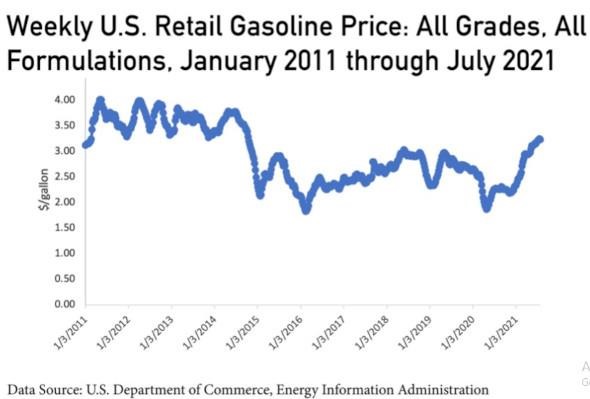By Mary Hightower
More people were hitting the road during the first half of 2021, with demand driving gasoline prices to their highest levels since 2014.
The July 29 report by the U.S. Department of Energy, Energy Information Administration, showed U.S. retail gas prices averaging $3.247 a gallon in the third week of July. This was the highest weekly average gas price since the second week of October 2014.

CHARTING A PATH — shows weekly national average retail gasoline prices for the past 10 years. (U of A System Division of Agriculture image)
“Gasoline prices have fallen slightly in the past week but remain among the highest in several years,” John Anderson said on Thursday. Anderson is an economist with the University of Arkansas System Division of Agriculture and the Dale Bumpers College of Agricultural, Food and Life Sciences.
Prices are far above last summer levels, when COVID restrictions sharply curtailed travel and, by extension, demand for gasoline. However, “prices are also up from pre-COVID levels: July retail gasoline prices have averaged about 15 percent higher than July 2019 and more than 40 percent higher than last July,” he said.
Seasonal consumption
“While gasoline consumption virtually always increases from January to July, this year, consumption increased 23 percent from January to July,” Anderson said. “This is the largest seasonal increase in gasoline consumption in EIA data going back to 1992.”
Higher consumption in spite of higher prices is an unmistakable sign of strong demand, he said. However, as consumers slacken their summer travel and COVID surges back into the picture heading into fall, prices may weaken.
“Looking ahead, fundamental support for gasoline prices should begin to soften, at least a little,” Anderson said. “Demand should already be weakening seasonally, a tendency that should accelerate as we move from summer into fall.
“Unfortunately, we may also see demand soften even more if the current increase in COVID cases leads to a return of restrictions and/or widespread risk avoidance behavior by consumers,” he said.
See Anderson’s full analysis of this report: hhttps://bit.ly/3xuREo1.
Source : uada.edu